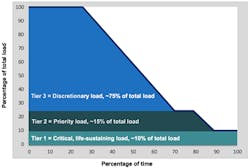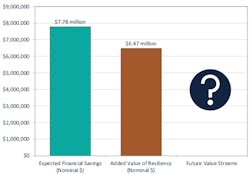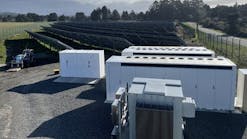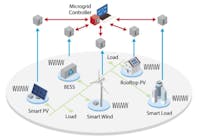In the face of Public Safety Power Shutoffs (PSPS) and rolling blackouts, the California Legislature passed Senate Bill (SB) 1339 in 2018 with the intention of promoting the commercialization of microgrids to provide grid resilience. For disadvantaged communities in particular, the increased policy focus on microgrids has signaled an energy landscape shifting away from traditional infrastructure and toward non-wires alternatives (NWAs), bringing with it hopes of greater community planning and local resilience.
However, one year after the regulatory proceeding at the California Public Utilities Commission (CPUC) began to implement SB 1339 (R. 19-09-009), with two out of three tracks completed, the CPUC has yet to quantify the value that microgrids can offer — or even discuss the value-of-resilience (VOR) in a practical manner. The CPUC is treating microgrids like a niche technology to be used solely when islanding from the grid, rather than one that can provide significant benefits to the distribution grid at all times. While the proceeding has focused on disadvantaged communities and increasing resilience at critical facilities, too little is being done and the proceeding is moving too slowly to effectively address the widespread needs of California communities before the next fire season.
Starting with short-term actions
Track 1 of the proceeding adopted short-term actions to accelerate the deployment of microgrids and resilience solutions. That track culminated with the CPUC allowing microgrids to go through a fast-track interconnection process, creating template single-line diagrams for certain microgrid configurations, removing sizing limits for energy storage, and allowing energy storage to import energy from the grid prior to scheduled grid outages. Each of these solutions represents small but important steps to reduce the impediments to the widespread deployment of microgrids — including community microgrids, which can serve entire communities. However, the few changes that were adopted did little to effectively incentivize increases in the amount of energy storage necessary to implement distribution-level resilience (or even to back up a significant number of critical facilities throughout the state).
Importantly, the decision for this track did not change the status quo, allowing utilities to continue reserving fossil-fuel generation as backup power without shaping a policy to guide the transition toward renewables-driven microgrids. The CPUC did approve a program proposed by Pacific Gas & Electric (PG&E) to develop community microgrids — the Community Microgrid Enablement Program (CMEP) — that has the potential to succeed but is yet to be implemented.
Importance of valuing resilience
From the beginning of the proceeding, the Clean Coalition, a California nonprofit, has taken a position during the comment process that the success of microgrids as technology is incumbent on developing a standardized VOR. Other parties concur. Since resilience is one of the main benefits a microgrid provides an end-user, it is undoubtedly a primary reason for deploying a microgrid. But without a proper methodology in place to quantify VOR, that value has been assumed to be zero — so it has not been accounted for when determining if a microgrid is economically feasible.
Throughout Tracks 1 and 2, we offered our VOR123 methodology — the only comprehensive VOR proposal presented to date. While the CPUC Energy Division staff did briefly mention our methodology in a concept paper, the concepts mentioned there were never discussed in depth or included in the official record of the proceeding.
As shown in the chart below, the VOR123 methodology divides the total electrical load of a facility into three tiers — critical, life-sustaining loads, which usually make up about 10% of the total electrical load; priority loads, which normally account for 15% of the total load; and discretionary loads, which make up the other 75% of the load.
The Clean Coalition found that indefinite renewables-driven resilience for a facility is worth an adder of around 25% on top of the normal cost of energy. In our feasibility analysis for the Santa Barbara Unified School District (SBUSD) solar microgrids, we found that the district would be able to get these massive resilience benefits for free, in addition to millions in guaranteed bill savings. These impressive figures made it easy for the SBUSD to proceed with the projects.
Ignoring microgrid economics
On Jan. 14, 2021, the CPUC passed a decision that includes a newly structured rate schedule for microgrids but does not offer a VOR or credit any other grid services that a microgrid can provide. This means that what the CPUC terms "cost-responsibility surcharges" (for example, departing load charges, standby charges, and non-bypassable charges) will suffocate the economics of a microgrid project.
There was some debate in Track 2 about crediting microgrids for providing resilience and grid services to the distribution grid. But the utilities opposed this credit as cost-shifting and, as a result, no credit for microgrids was included in the proposed decision. During the stifled debate on the microgrid rate structure and throughout both Tracks 1 and 2, this concern has repeatedly been used to deny active party proposals related to compensating microgrids — though "cost-shifting" is an extremely vague term.
Foundational issues
The microgrids proceeding still needs to delve into a number of important issues, including the cost-shifting concern:
1. Cost-shifting: As Vote Solar and The Climate Center mentioned in recent comments, without a practical definition of cost-shifting, anything the utilities spend money on that does not appear to directly benefit all ratepayers can be construed as cost-shifting. This is especially true if the CPUC does not properly account for the wide range of benefits that a microgrid provides to the grid.
2. Normal operations of a microgrid: To date, the microgrids proceeding has treated microgrids as technology to be used solely for islanding during outages, ignoring the normal operations of a microgrid during the vast majority of the time when the grid is operational. Microgrids can provide valuable grid services during normal operations.
3. Resilience and grid services: It is essential that the CPUC ascribe a standard VOR for microgrids. Additionally, an effective tariff should acknowledge and value the plethora of benefits a microgrid can provide to the grid, including peak shaving, frequency balancing, and voltage regulation.
4. Compensating community microgrids: The current rate schedule included in Track 2 is intended for what the CPUC refers to as "single-customer microgrids," also known as behind-the-meter (BTM) microgrids. While this rate schedule is an important step, it does not yet factor in community microgrids, which are the ultimate goal that California should strive to achieve. The Track 3 Resiliency and Microgrid Working Group has discussed intentions to develop a community microgrid tariff but is lacking a timeline and will not succeed in creating a comprehensive tariff without the other foundational pieces in place to ensure a fair compensation mechanism.
Cutting utilities off from fossil-fuel backup power
A significant worry that has arisen from Track 2 is that utilities will continue to reserve fossil-fuel generation as emergency backup power for years longer than originally intended. In the Track 1 decision, the CPUC stated that fossil-fuel generation would be acceptable only in the short term (for example, the 2020 fire season) because of the inability to deploy clean energy solutions before the 2020 fire season began.
However, when renewables-driven microgrid solutions were discussed for substation-level backup power during Track 2 in August 2020, both CPUC Energy Division staff and the utilities rejected party proposals that offered to deploy solutions by 2021. Unsurprisingly, there was widespread outrage that the Track 2 proposed decision included a transition framework that would allow utilities to reserve fossil-fuel generation into 2022 — and potentially even into 2023.
Need for a more forward-looking approach
Tracks 1 and 2 of the microgrids proceeding were so focused on meeting the December 2020 statutory deadline that essential topics were discussed only at the most basic level, leading to solutions that are not proactive enough to truly encourage microgrid commercialization.
In multiple instances, the CPUC adopted overly conservative solutions, citing a concern about unintended consequences to limit the types of microgrids that a decision benefited, without an explanation. For example, the amendment to Rule 18/19 (which limits energy sharing between adjacent facilities) is only extending the rule to allow energy sharing between adjacent critical facilities that are both owned by municipal corporations — solely in emergency outage situations.
At multiple points in the proceeding, parties have attempted to put a greater spotlight on quickly deploying critical facility microgrids, especially in disadvantaged communities. The CPUC has yet to answer a motion submitted by a group of Joint Parties — including the Green Power Institute, the Microgrid Resources Coalition, the Clean Coalition, and others — that would refocus the proceeding on crafting a community microgrid compensation tariff and more ambitious solutions.
To achieve the goal of commercializing microgrids and providing resilience to the state, the CPUC must adopt a more forward-looking approach than it has to date.




